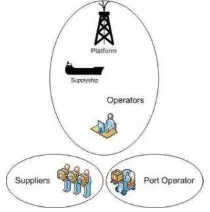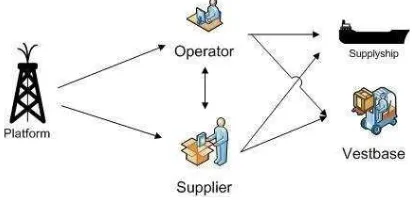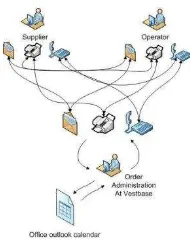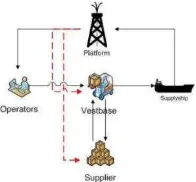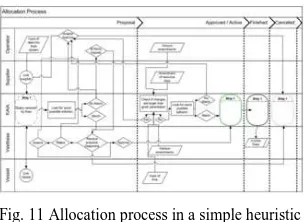Supply Chain Information for Collaborative Port
Allocation
Mutmainah
#, Umi Marfuah
#, and Ahmad Andreas Tri Panudju
##
Industrial Engineering – Engineering Faculty Muhammadiyah University of Jakarta. 1
mutmainah.mattjik@yahoo.co.id,
2
umi.marfuah1 @yahoo.co.id,
3
Panudju2002@yahoo.com
Abstract— There has been a complex coordination process to make resources meet demand, since a demand into being to a ship arriving port with the cargo onboard. This research will look at how collaboration could make port allocation more efficient and flexible. The purpose is to come up with a new tool for collaborative work, which integrates with external data to support decision making. Important goals for this research will be to improve utilization of resources, and create a better flow of information. Game theory (hereafter GT) is a methodology of decision making involving multiple parties such as persons, companies or agents. As each port allocation in reality requires a different set of solutions it would make sense to define a port allocation as an Ad hoc activity. Collaboration must be inclusive, include all leadership and participants of the system to be legitimate. This is done by allowing them to add, subtract, and communicate around each port allocation in order to find converging solutions. It would be useful to add some data from third party information providers. This research answers some key questions concerning further development. One of the expected benefits of implementing such a system are far better information flow that hopefully will increase port's capabilities to overcome these problems. Other benefits may be the ability to benchmark activities in order to track changes in performance. The ability to run historical and prospective simulations could contribute to an increase in utilization, efficiency and understanding of the supply chain.
Keywords— Collaborative, Game Theory, Port Allocation, Transparent Supply Chain
I.INTRODUCTION
Once Mr President Jokowi visited Tanjung Priok, he was able recognized at once the big problem of the port is due to a long dwelling time. It takes more than 4 days, which is considered the longest among ASEAN countries. These problems occurred due to long coordination and bureaucracy procedure which are involved of 18 ministry.
There has been a complex coordination process to make resources meet demand, since a demand into being to a ship arriving port with the cargo onboard. This means to locate a ship to a given quay at a given time to be served. This process involves finding the appropriate quay that can serve the necessary requirements for each operation.
Figure 1 gives an overview of the central part of Vestbase, and shows the different quays and port infrastructure. The main constraint in terms of quay resources is handling of bulk
loads at the different quays. Each quay is only equipped to deliver a given selection of bulk loads. This gives challenges in terms of port allocation as pressure lies on the quays that can deliver these bulk goods.
Fig. 1 Overview over port area and quays
General cargo can be delivered by crane at any given quay. It is however a question of convenience and time, in terms of internal travelling distances inside the port facility, which might influence on the choice of quay.
Another uncertainty factor is the number of different participants in the system. How things are done might vary from task to task, depending on whose involved.
The participants in a port allocation process can be divided into three main categories; operators, suppliers and the port operator as shown in Figure 2. To work out a proper work flow for each of the three categories is difficult as there are no well defined methods on how requests and communication are handled through the system. In practice there is an extensive use of mail, phones and fax back and forth in order to settle an agreement. This brings complexity to the system, and makes traceability difficult.
A. Operators
In terms of operator in this research, it makes sense to expand the meaning of the word operator. There are ships arriving at port that not necessarily are under direct operational control from Vestbase. Ships might work on behalf of Vestbase, but are operated through agents, suppliers or even the ships itself (Øien, 2015). Thus the term operator should include all participants in the system that operates a ship, and/or are able to book a port call.
Fig. 3 Operator work flow chart
Figure 3 gives a simplified look at reality for port allocation from the operator side. From beginning to end, communication passes through several segments, and requirements is subject to change more than once during this process. In reality the figure could be filled with arrows back and forth between the different segments. The final communication between them and port operator goes through their logistical base operation centre at port (Rolland, 2015). The number of participants creates challenges in terms of roles within a port allocation system.
B. Suppliers
Firms that deliver goods and/or services to the operators and the ships at port are defined as suppliers in this research.
Fig. 4 Suppliers and operator work flow chart
Figure 4 shows how communication of demands passes between the different participants when suppliers also enter the picture in the port allocation. Some of the suppliers have own representatives at the offshore installations that are responsible for logistical operations of their own products (Sundsey, 2015). They coordinate necessary supplies to the onshore office, which coordinates with the operator and port operator. There is also, situations where suppliers may act as operators of own ships (Hansen, 2015).
C. Vestbase
Vestbase is the port operator which provides port and
warehouse facilities. They are responsible for coordinating the port allocation and have the final decision in terms of allocation.
Fig. 5 Vestbase work flow chart
Orders are entering through Vestbase's booking administration as shown in Figure 5. They allocate the necessary resources in terms of loading equipment and quays. Today this information is gathered and organized through the use of office outlook schedules. Each quay has its own schedule. This has its limits in terms of collaboration, as the schedules are not shared with any of the suppliers or operators. It is also limited in terms of having an automatic response to available bulk resources. Vestbase also act as a supplier through their own bulk sales.
D. Other Complexities
The reality is however much more complex and might make it difficult to shorten the loading time; a vessel might only take bulk loads at the back end of the ship. To load the ship, the supplier might have to lay more bends in order to reach the intake and thus makes loading time longer. The vessel on the other hand is unable to lie the other way as it might lose its communication with satellites.
E. Information Sharing in The Supply Chain
An important element in port allocation is information sharing to make coordination of activities work properly. With the existing information model there is an extensive, but insufficient amount of information passing between the different participants. It's actually desirable to increase the flow of information. The requirements are also subject to change several times during a port allocation.
Some main operators create a Shipping pool to be able to utilize shipping resources in a more efficient way than with normal conduct. Internal communication between different departments on the offshore installations is however not always satisfactory and leads to separate supply chains with little or next to no coordination (Kon-Kraft, 2004). This lack of communication between departments might hamper the intentions of a shipping pool
As offshore employees in charge often are free to procure supplies and equipment themselves, it often generates frequent orders and several transport hauls. Orders might also be placed directly with the supplier without informing the central warehouse administration (Kon-Kraft, 2004).
might be received by fax, confirmed by mail or phone or vice versa. The information is coordinated by Vestbase. In practice the actual allocation is presented as schedules in Microsoft Office Outlook schedules - one schedule for each quay.
Fig. 6 Modes of communication between participants
This research will look at how collaboration could make port allocation at Vestbase more efficient and flexible. The purpose is to come up with a new tool for collaborative work, which integrates with external data to support decision making. An important feature is that it also could work as a basis for billing. Important goals for this research will be to improve utilization of resources, and create a better flow of information.
II. RESEARCH METHODOLOGY
The research has been done through a field observation and descriptive analytic through many literatures. The research based on the Game theory. Game theory (hereafter GT) is a methodology of decision making involving multiple parties such as persons, companies or agents. For instance, each company must consider what other companies will do. Classical literatures (Nash 1944, Von Neumann and Morgenstern 1944) together with applications of GT in industrial organizations (Gibbons 1992, Philips 1995, Tirole 1988) usually discuss four classes of games: static as well as dynamic games of complete information and static as well as dynamic games of incomplete information. Corresponding to these four classes of games there are four notions of equilibrium in games: Nash equilibrium (NE), subgame-perfect NE, Bayesian NE, and subgame-perfect Bayesian equilibrium. The NE is a solution concept of a game, in which each player is assumed to know the strategies to be taken by the others and no player can be better off by changing his or her own strategy unilaterally. A subgame-perfect NE is a refinement of a NE used in dynamic games if it represents a NE of every subgame of the original game. Bayesian NE is a solution concept of Bayesian games where at least one player is not sure of the type (and so the payoff function) of another player, which might result in some implausible equilibria in dynamic games. To refine the equilibria generated by the Bayesian Nash solution concept or subgame perfection, one can apply the perfect Bayesian equilibrium solution concept (Wikipedia, 2015).
A player in a game is a person or a business community
making decisions or choosing a strategy from a set of given options. One player's decision affects that of the others. In a static game, players make decisions simultaneously without knowing information of other's decisions. In a dynamic game, players make decisions at different moments, i.e., a sequential decision making process happens due to the fact that other's decisions have been disclosed. A strategy in a game is one of the options from which a player may select. Such decision making process may be based on historic experience of himself and/or information disclosed by other players. Traditional applications of GT attempt to find equilibria. In an equilibrium each player of the game has adopted a strategy that none of the players involved is likely to deviate from.
Traditional applications of game theory attempt to find equilibria. In an equilibrium each player of the game has adopted a strategy that none of the players involved likely tends to deviate. Payoff means what a player gets after choosing a strategy. Pursuit of payoff maximization, usually, is the utmost goal of a player.
In this research, a player can be, e.g., a liner shipping operator, or a tramp shipping operator, or a community of liners -- an alliance -- behaving as a whole in the market. A set of strategies can include whether to cooperate with other competitors or deviate from the current situation, etc.
All the players have similarity in attempt to avoid overcapacity, cut-throat competition, lack of diversification, and other negative factors. Therefore, shippers or carriers can be regarded as players in games as they will not take action without considering what their competitors do.
Besides freight rates, a shipper can decide to accept one of the carriers' offers taking into account his expectation of other shippers' decisions to avoid congestion, peak season pricing, risk, etc. The interactions among players in the shipping industry have a considerable impact on each player's strategy set.
Besides that, there is a growing trend for related service providers to integrate. Therefore, GT can be a helpful tool in the analysis of the shipping industry given features of the industry that the decisions of multiple players affect each player's payoff.
III. RESULT AND DISCUSSION A. Preconditions and Principles
Each port allocation has its unique layout. Different ship, needs and requirements, people, agents, operators and so on. As each port allocation in reality requires a different set of solutions it would make sense to define a port allocation as an Ad hoc activity. This will enable a better use of resources, greater spontaneity and recognition.
not actually take part in. Those who know and have proven to give useful solutions can decide. This is a matter of trust.
A collaborative process is like most other processes in need of some sort of leadership. Even if collaboration is supposed to be a process where the participants must be self governing, and all should take part in the process of making a joint decision. The leaders just played a role of guidance and coordination, not top-down command..
For a collaborative port allocation system to be functional there might be several criteria’s that needs to be in place. It might be interesting to enlighten a few but important criteria’s;
1. All regular users of Vestbase’s facilities need to take part.
If not, the collaborative system will only be a parallel subsidiary to the normal operation, and might actually double the work load. Collaboration is also meaningless without all participants.
2. A common goal and understanding of why this is done. Participants need to understand the incentives.
3. A software that is easy to use and easy to access. Without it, collaboration could easily be met with unwillingness. In other words - collaboration needs to be simple; everyone has to take part and understand why they do it.
B. Transparency in The Decision Making P rocess 1) Transparent Supply Chain
A transparent supply chain implies that vital and useful information is available to more than one participant of the supply chain. That means that decisions, strategies and changes can be dealt with on the basis of more information and better understanding among the participants.
Fig. 7 Simplified supply chain with and without transparency
Figure 7 above shows an example of a simplified supply chain of port allocation at Vestbase. The platform reports its need and requirements onshore to the operators, which in turn hopefully coordinates with Vestbase. Vestbase ships it onboard the supply ship. The black arrows indicate a less effective line of communication. The different segments information has to travel through, could result in both delays and omissions in the information. If Vestbase immediately could see the information coming from the platform, they could in advance make sure that supplies were available and shorten the lead time. Although this is a simplified reality, it illustrates how transparency in terms of information exchange could help in doing the supply chain more efficient.
The time information is shared is also a critical factor. If a need as an example arise at the platform, and this requirement
is not shared until the last minute, even though the need has been obvious for some time, it could result in unfortunate and insufficient actions, and ripple effects throughout the supply chain. The example from Figure 8 below shows how an unwanted situation could develop due to lack of information sharing. As the supply ship is about to start on round-trip 2, the first platform release an urgent requirement that needs attention. This results in cancelation of round-trip 2, and could cause another platform to shut down. The example might seem a bit far-fetched, but could arise if needs that has been known for a while, is not being announced until the last minute.
Fig. 8 An unwanted situation due to lack of information exchange
The just in time approach that could appear from the offshore installations causes challenges upstream in the supply chain. The sudden rise in demand could be managed by increasing the number of supply ships, whether or not this is profitable is outside the scope of this research. It is however important to bring forward a common understanding for all participants on how the supply chain works, its abilities and limitations, and how the different participants influence on it. The decision making process will derive advantage from this understanding.
Instead of adopting transparency as a blanket policy for the entire system/supply chain, it is proposed that transparency is to be used for a specific purpose or project (Lamming Richard C et al., 2001). Thus it will be possible or beneficial to shift between the different principles of transparency in various stages of the allocation. A timely translucent system will also be beneficial for the users own flexibility. If everybody could see what everybody was doing all the time there is change that the system could get formal and watchful. Thus the freedom that generates flexibility would disappear.
As can be seen; no transparency at all will give situations where there are very difficult to be strategic and deal with sudden changes. Port allocation is a process that has a high rate of changes, thus sharing information about actual needs and requirements could improve the allocation considerably.
Fig. 9 No transparency, no strategy to deal with congruent needs
transparency will take place. The two operators are not able to see what needs the different ships are having, consequently they
both book the in on A. A is not able to serve two ships at once, thus it will either be first in first served or rejection on both12. No strategy for the port allocation is possible as no information is shared.
Fig. 10 Transparency, able to coordinate a strategy to serve congruent needs
Figure 10 shows a port allocation process where the needs of the two ships are shared between the different operators. One ship is in need of A, and the other is in need of both A + B. It would then make sense that the ship with needs of both A + B would start off with B before moving to A. Transparency enables an operational strategy that serves in favour of both operators.
2) Collaboration to optimize
To be able to achieve a better solution than given by the system, the participants need to be given the possibility to collaborate. This is done by allowing them to add, subtract, and communicate around each port allocation in order to find converging solutions.
The proposed allocation is first checked by the system against constraints and minimum requirements before Vestbase receives the proposal. This is revised and might be discussed with the operator to reach an agreement before the allocation is approved. Throughout the allocation there might be continuously amendments to the allocation.
Figure 11 below shows how the port allocation system could work when adding the different states, participants and flexibility together.
Fig. 11 Allocation process in a simple heuristic
As previously discussed it would be useful to add some data from third party information providers. Some of the data is available free of charge. Most importantly; it's available, updated by others and could be useful information for the allocation process. These are no need for Vestbase to maintain this information themselves.
C. External Sources 1) AIS
Vestbase has access to AIS (Automatic Identification System for Ship) data through Oddstal Shiplog. AIS data contains both static and dynamic information about each ship. Adding information from the ship could improve the accuracy of the system in terms of arrival times. It might however be situations where the ship does not report arrival times into the system for various reasons. Adding data from AIS could then work as a secondary information source if first hand data is not available. AIS signals from the ships gives information about ETA, this is however information that the ship has to remember to provide. It's also possible to assign sectors in the AIS map so that when a ship enters the assigned area, it's possible to calculate an estimated time of arrival. Subsequent to the input of ETA by the operator in the initial allocation proposal, ETA from the vessel or AIS could give support to a more accurate ETA.
2) Ship Information
This should be gathered from a more reliable source. There are several providers of ship's registers where this information could be gathered. This is information that needs to be cross referenced with the constraints of each quay and needs to be accurate. It makes sense that this information should be gathered from third party providers.
3) Shipments Information
Information about cargo (general cargo), or shipments could be useful to implement to support the basis for invoice. Vestbase are charging per tonnage loaded, and this is weighed by the trucks. There is being work done to create a system that tracks individual shipments. By implementing this data one could get a more integrated system for billing, resulting in fewer errors and time saved.
4) Weather
There is also a possibility to implement information about weather and tides. Easy access to information about the next hours could give indications about delays in arrivals and loading operations. It could also be possible to implement information about tides in the event of heavy loading operation that could only take place at high tide, due to limitations in the draught.
5) Contracts
It might be possible to collect and display information about each different contract when there are elements of uncertainty in how to charge the different vessels.
6) KML
7) UUID
UUID (Universally Unique Identifier) is an identifier standard that is used in software's to enable distributed systems to uniquely identify information without significant central coordination (Wikipedia m, 2015). Each port allocation might be given a unique UUID to be able to identify it, and to be able to relate all communication to one specific UUID. For instance it might be possible to tie a mail string to a given port allocation by giving the UUID in the header field of the e-mail. This will assure that all communication can be identified by the system, gathered and logged under one specific port allocation.
D. Views for Everyone
Each different participant needs to be given different views and rights in the system. Figure 12 shows how this will work. The operator and suppliers are the main contributors to the system, while Vestbase acts more like a supervisor that approves allocations and make sure that operations go without delays.
Fig. 12 views and functionality for different users of the system Operator: The operator generates the allocation, input ship and necessary resources. It's also possible for the operator to request quay. The system will however check available quays up against the ship's specifications, and available resources. Once the allocation is approved, the amend process will give the operator chances to add and subtract resources.
Supplier: Once the operator has assigned the supplier to an allocation, he can take part in adding and subtracting resources to the allocation. The supplier will contribute with more accurate data on when loading and discharging operations are done.
Vestbase: Vestbase will approve and have the final words in the allocation process. They will not have a saying in resources, but might change time and quay allocation. They will also need to be able to generate allocations as ships might arrive that do not have an operator that take part in the collaborative port allocation system.
E. Implementation
Implementing the system requires planning and relies first
and foremost on the participation of all participants. It might be that building a simple system with only the basic functions at first might be best. This lets people get used to the system and see advantages before adding more advanced features. Implementation could be divided into two phases:
Phase 1:
- Building: Planning, building and testing the system
would take time. The first stage of the building should only include functions that let the users get familiar with the layout and basic principles of the system. This includes the basic collaborative features such as input of requirements, amendments and communication. It's important that there is a possibility to measure the systems performance through KPI's from day to day. - Training: Information and training of participants is
necessary before the system goes on. Training sessions, and information videos will contribute to a greater understanding of the system.
- Launch: Give incentives to contribute as good as
possible to the participants. There should be possibilities for the users to give feedback to system to improve its functions.
Phase 2:
- Expansion: Once the input data are began to get
accurate it is possible to use this for a basis for billing. It's important to inform users that input data will form a basis for billing.
IV.CONCLUSION
Although the system is yet to be build and effects of its implementation are unknown at this point, this research give answer to some key questions concerning further development.
A. Is it possible?
The system in its entirety is quite small and does not do much. It gathers information from other sources, and displays it to the participants in order to help improve the port allocation process. The hard part is to be able to gather necessary data in a way that it is possible to make use of it within the system, together with creating a graphical user interface (GUI) that is intuitive. Once a satisfactory GUI has been developed, and permissions to gather data have been granted, development of the system rests on technological knowledge and know-how. Taking into consideration that it is technologically achievable, and participants are willing to take part; development and implementation of the system is possible.
B. Is it beneficial?
supply chain. C. Further work
There are some aspects that this research have not dealt with, but could be of interest for further work:
To let the system optimize the allocations, a closer study of the conditions is necessary. It is required that criteria's are calculated down to single units in order to find an optimized allocation.
It would be interesting to have a closer look at the value of having a vacant quay to serve bigger and more demanding ships, to justify the process of giving participants what so called worst possible allocation. The option value of having a vacant quay will most likely vary depending on situation, requires a more thorough research.
REFERENCES
[1] BIZED.CO.UK. The Nash Equilibrium [Online]. Available: http://www.bized.co.uk/educators/1619/economics/macrocont/activity/g ametheory3.htm [Accessed April 12 2015], 2015.
[2] BYRON, M. Satisficing and Optimality. Ethics -The University of
Chicago, 109. CROW, K. 2002. Collaboration [Online]. Available:
http://www.npd-solutions.com/collaboration.html [Accessed March 18 2015], 1998.
[3] DON TAPSCOTT & WILLIAMS, A. D. Wikinomics: How Mass
Collaboration ChangesEverything, Portifolio, 2008.
[4] ELIYAHU M GOLDRATT.The Goal: A Process of Ongoing
Improvement, North River Press. ENERGILINK.TU.NO. 2015. Heidrun
[Online]. Available: http://energilink.tu.no/leksikon/heidrun-feltet.aspx [Accessed April 20 2015], 2004.
[5] FOUR GROUPS, L. The Tension in Collaboration [Online]. Four
Groups Ltd,. Available:
http://www.fourgroups.com/blog/archives/24/the-tension-in-collaboration/ [Accessed March 12 2015], 2008.
[6] GARRISON, B. Math professor explains John Nash's Nobel
Prize-winning theory [Online]. Available:
http://www.udel.edu/PR/UDaily/01-02/nash111802.html [Accessed March 12,2015], 2002.
[7] GENEROZOVA, O. Types of collective intelligence [Online]. Available: http://en.wikipedia.org/wiki/Collective_intelligence#Types_of_collectiv e_intelligence [Accessed 24 november 2014], 2009.
[8] GIBBONS R. A Primer in Game Theory. Harvester Wheatsheaf, Hertfordshire GRAY, B. 2001. Collaborating: Finding Common
Ground for Multiparty Problems, Jossey-Bass, 1992.
[9] HANSEN, B. March 09 2015. RE: Managing director, Maritime Waste Management, Vestbase.
[10] KON-KRAFT. Kartlegging av kostnadsbildet pa Norsk sokkel. KYSTVERKET. 2015. Automatisk Identifikasjons System - AIS
[Online]. Available: http://www.kystverket.no/?did=9140988 [Accessed May 03 2015], 2004.
[11] LAMMING RICHARD C, CALDWELL NIGEL D, HARRISON DEBORAH A & WENDY, P. Transparency in supply relationships: Concept and practice. Journal of Supply Chain Management, 37, 4 – 10, 2001.
[12] LONDON, S. Collaboration and Community [Online]. Available:
http://www.scottlondon.com/reports/ppcc.html [Accessed March 16 2015], 1995.
[13] MINDTOOLS. Effective Decision Making [Online]. Available: http://www.mindtools.com/pages/article/newTED_00.htm [Accessed
Empowered Teams : Creating Self-Directed Work Groups That Improve
Quality, Productivity, and Participation, Wiley & Sons, Incorporated, John, 1991.
[17] ROLLAND, B. E. 02 Feb 2015. RE: Consultant Logistics Base Operations, Statoil.
[18] SHIPLOG 2015. Shiplog AIS historical data 2009. SIMON, H. 1991.
Models of my life, Basic Books, Inc.
[19] STAMP, G. The Individual, the Organisation and the Path to Mutual
Appreciation [Online]. Available: http://www.bioss.name/?page_id=25
[Accessed March 23 2015], 2008.
Economic Behavior. Princeton University Press, Princeton, 1944.
[23] WEISBORD, M. R. Discovering common ground, 1992.
[24] WIKINOMICS. Wiki collaboration leads to happiness [Online]. Available:http://www.wikinomics.com/blog/index.php/2008/03/26/wiki-collaboration-leads-to- happiness/ [Accessed March 15 2015], 2008. [25] WIKIPEDIA A. wiktionary - Ad Hoc [Online]. Available:
http://en.wiktionary.org/wiki/ad_hoc [Accessed March 17 2015], 2015. [26] WIKIPEDIA B. XML [Online]. Available:
http://en.wikipedia.org/wiki/XML [Accessed March 21 2015], 2015. [27] WIKIPEDIA C. Decision making [Online]. Available:
http://en.wikipedia.org/wiki/Decision_making [Accessed March 29 2015], 2015a.
[28] WIKIPEDIA C. Satisficing [Online]. Available: http://en.wikipedia.org/wiki/Satisficing [Accessed March 23 2015], 2015b.
[29] WIKIPEDIA E. Game theory [Online]. Available: http://en.wikipedia.org/wiki/Game_theory [Accessed April 9 2015], 2015.
[30] WIKIPEDIA F. Nash Equilibrium [Online]. Available: http://en.wikipedia.org/wiki/Nash_equilibrium [Accessed April 9 2015], 2015.
[31] WIKIPEDIA G. Mashup - Web application hybrid [Online]. Available: http://en.wikipedia.org/wiki/Mashup_(web_application_hybrid)#Types_ of_mashups [Accessed April 13 2015], 2015.
[32] WIKIPEDIA H. Augmented reality [Online]. Available: http://en.wikipedia.org/wiki/Augmented_reality#cite_note
Azuma_survey-1 [Accessed April 26 2015], 2015.
[33] WIKIPEDIA I. Gantt chart [Online]. Available: http://en.wikipedia.org/wiki/Gantt_chart [Accessed April 27 2015], 2015.
[34] WIKIPEDIA J. RSS [Online]. Available: http://en.wikipedia.org/wiki/RSS [Accessed May 3 2015], 2015. [35] WIKIPEDIA K. Keyhole Markup Language [Online]. Available:
http://en.wikipedia.org/wiki/Keyhole_Markup_Language [Accessed May 3 2015], 2015.
